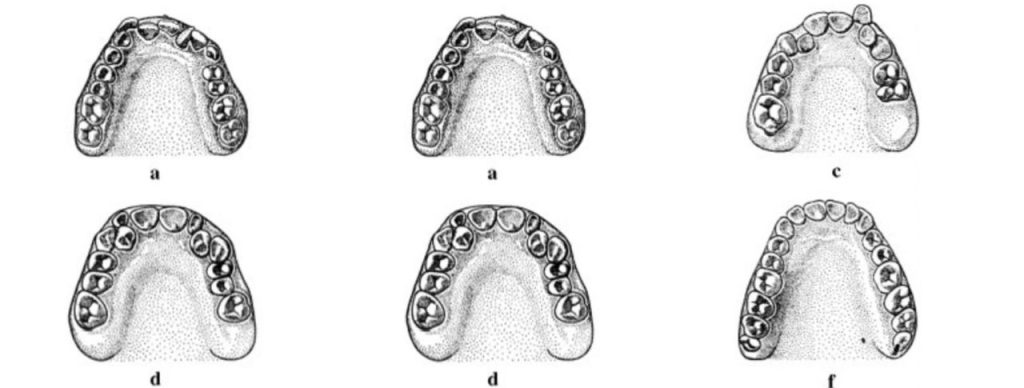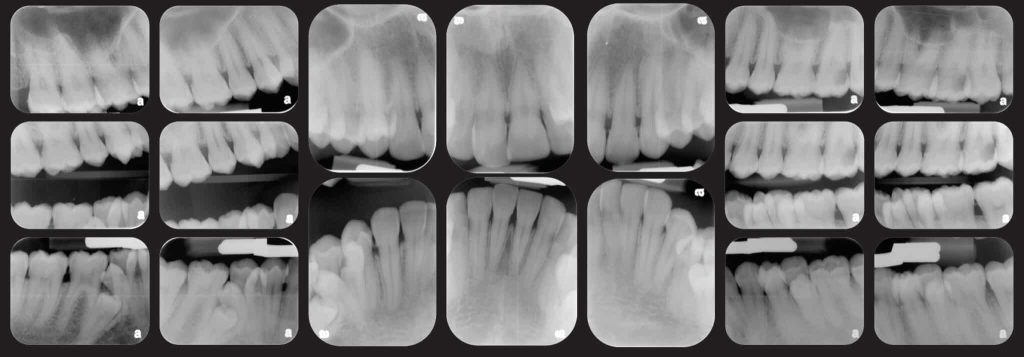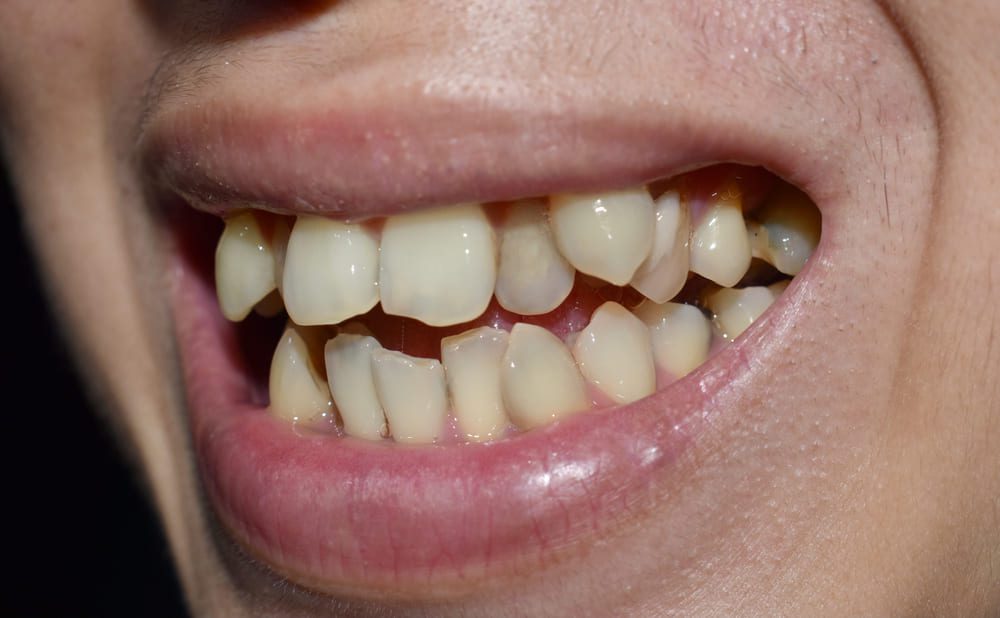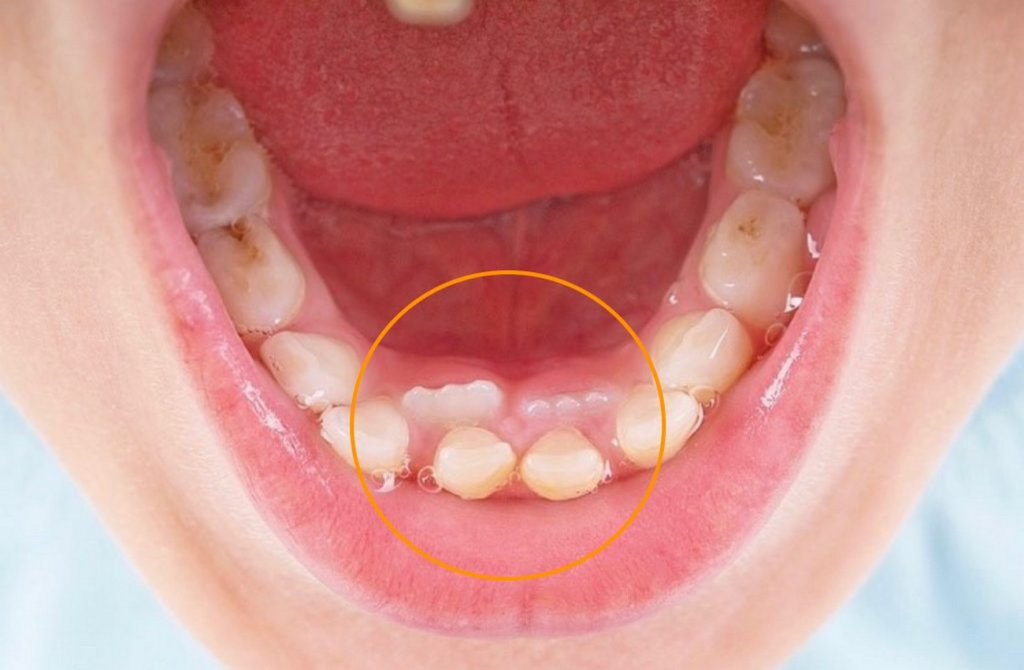Extra teeth in children’s gums can often appear between the two upper front teeth, causing disruption in the alignment of the child’s teeth and the growth of surrounding teeth. This condition is typically known as hyperdontia or supernumerary teeth.
What is Hyperdontia?

Hyperdontia refers to a condition where one or more extra teeth develop in the mouth. These additional teeth can be either primary (baby) teeth or permanent teeth. A child is considered to have hyperdontia if they have more than 20 deciduous teeth or more than 32 permanent teeth. Studies suggest that hyperdontia affects between 1% and 4% of the population, with males being more frequently affected than females. Most cases of hyperdontia involve a single extra tooth, although multiple supernumerary teeth can occur.
Types of Extra Teeth in Children’s Gums

Hyperdontia can manifest in various locations within the mouth and is classified based on both location and shape:
Location-based classifications include:
- Mesiodens: The most common type, typically located between the upper incisors.
- Distodens/Distomolar: Extra fourth molars, which may present like impacted wisdom teeth.
- Natal Tooth: An extra primary tooth that appears at birth or shortly thereafter.
- Paramolar: Extra molars that erupt buccally (toward the cheek) or palatally (toward the roof of the mouth).
- Peridens: Extra teeth that appear outside the midline of the dental arch.
Shape-based classifications include:
- Supplemental: Teeth that resemble normal teeth in shape, most commonly occurring as primary teeth.
- Conical/Peg-shaped: Teeth that are wide at the base and taper to a sharp point.
- Tuberculate: Teeth with a barrel or tube shape, often with abnormal roots.
- Compound Odontoma: A mass of dental tissue that includes multiple tooth-like structures.
- Complex Odontoma: A disordered mass of tooth-like tissue.
- Molariform: Teeth shaped like premolars, usually located near the molars.
Causes of Hyperdontia

The exact cause of hyperdontia is not fully understood, but it is believed to result from a combination of genetic and environmental factors:
- Genetics: Hyperdontia can be inherited, meaning if a family member has had it, a child is more likely to develop it.
- Abnormal Tooth Development: Overactivity of the dental lamina (the layer of cells responsible for tooth formation) can lead to the development of additional teeth during the early stages of tooth development.
- Environmental Factors: Exposure to certain medications or environmental factors, such as radiation, may contribute to hyperdontia, though this is less well documented.
For more on the genetic and environmental factors affecting dental health, you can refer to The Connection Between Oral Health and Systemic Diseases.
Underlying Conditions Linked to Hyperdontia

Hyperdontia is often associated with several genetic syndromes and conditions, including:
- Cleft Lip and/or Palate: A congenital condition causing openings in the upper lip and/or palate.
- Gardner’s Syndrome: A genetic disorder causing growths in various body parts, including the jaw and skin.
- Cleidocranial Dysplasia: A condition that affects the development of the collarbones and skull.
- Fabry Disease: A syndrome causing skin rashes, abdominal pain, and other symptoms.
- Ehlers-Danlos Syndrome: A condition affecting connective tissue, resulting in flexible joints and other physical issues.
- Down Syndrome: A genetic condition caused by an extra chromosome that affects physical and cognitive development.
Symptoms of Hyperdontia
The most apparent symptom of hyperdontia is the presence of extra teeth. However, other symptoms may also suggest the condition:
- Crowded Teeth: If the child’s teeth are crowded or there is difficulty chewing, hyperdontia could be the cause.
- Delayed Tooth Eruption: If a child’s teeth do not emerge at the expected time, this may be a sign of extra teeth.
- Speech Problems: Difficulty speaking may indicate extra teeth affecting oral function.
- Soft Tissue Bumps or Swelling: The gums may swell due to the presence of extra teeth.
- Wide Gaps Between Upper Front Teeth
- Malformed or Fused Teeth
- Protruding Teeth
For more on the importance of early detection and regular check-ups, refer to Why Regular Dental Checkups Matter.
Treatment for Hyperdontia
The treatment for hyperdontia depends on the severity of the condition and the issues caused by the extra teeth. Treatment options include:
- Early Diagnosis: Early detection through regular dental visits is important. X-rays may be used to confirm the presence of extra teeth.
- Tooth Extraction: If extra teeth are causing problems like pain, crowding, or difficulty with oral hygiene, removal of the extra teeth is often recommended. This procedure is typically done under local anesthesia.
- Orthodontic Treatment: In cases where extra teeth do not immediately cause issues, orthodontic treatments like braces can be used to align the teeth properly and prevent future problems. For more details, you can read Choosing the Best Orthodontic Treatment.
- Surgery: If the extra teeth are deeply embedded, surgery may be necessary to remove them.
- Monitoring: Regular follow-up visits are important to ensure no further dental problems arise.
- Proper Oral Hygiene: Ensuring that the child maintains good oral hygiene is essential after treatment.
For more information on how to maintain good oral hygiene and preventive care, you can refer to How to Prevent Tooth Decay.
Complications of Hyperdontia
If hyperdontia is left untreated, it can lead to several complications:
- Delayed Eruption of Adjacent Teeth: Extra teeth can prevent normal eruption of nearby teeth.
- Crowding: Extra teeth can lead to overcrowding of the permanent teeth, which may require orthodontic correction.
- Cysts and Tumors: The presence of extra teeth can cause the development of cysts or tumors.
- Fusion with Other Teeth: Supernumerary teeth can fuse with adjacent teeth, disrupting normal tooth development.
- Tooth Decay: The shape or positioning of supernumerary teeth can make it difficult to properly clean teeth, leading to decay.
- Gum Disease: Extra teeth can contribute to gum inflammation or infections.
- Misalignment: Supernumerary teeth can cause misalignment or impaction of normal teeth.
Extra Tooth Behind Baby Tooth

An extra tooth growing behind a baby tooth can result from two main phenomena: hyperdontia and the eruption of permanent teeth. Here’s a breakdown:
- Hyperdontia: This is the condition of having extra teeth in any part of the mouth. It affects about 1-3% of children and can appear as extra teeth behind or in front of baby teeth.
- Eruption of Permanent Teeth: This occurs when permanent teeth begin to erupt before the corresponding baby teeth have fallen out, typically between the ages of 5 and 7.
Impacted Extra Teeth
Impacted extra teeth in children refer to teeth that fail to emerge through the gums and become embedded in the jawbone or gum tissue. Signs of impacted teeth include swelling or redness in the gums, difficulty opening the mouth, and infection symptoms like pus or bad breath. Causes of impacted extra teeth include:
- Insufficient Space: A lack of room in the jaw can prevent teeth from emerging properly.
- Genetics: A family history of dental issues may increase the likelihood of impacted teeth.
- Crowding: Baby teeth may not fall out on time, obstructing the path for other teeth.
- Abnormal Tooth Position: Teeth may grow sideways or at an unusual angle due to developmental abnormalities.
Conclusion
Hyperdontia or supernumerary teeth can cause a variety of dental issues, from crowding to misalignment. Early diagnosis and treatment are essential to prevent complications such as delayed tooth eruption, difficulty with oral hygiene, and the need for more invasive procedures later. If your child has extra teeth or you suspect the presence of supernumerary teeth, seek a pediatric dentist’s evaluation to ensure proper treatment and care.
By maintaining regular dental visits, practicing good oral hygiene, and addressing issues related to hyperdontia promptly, parents can help their children avoid long-term dental problems.
For more information or to schedule a consultation, please visit Contact Us.
Frequently Asked Questions (FAQ)
1. What is the most common location for extra teeth in children?
The most common location for extra teeth, or supernumerary teeth, is between the upper front teeth (known as mesiodens).
2. Can extra teeth cause pain or discomfort?
Yes, extra teeth can cause pain or discomfort, especially if they crowd the mouth or affect the alignment of other teeth.
3. How are extra teeth diagnosed?
Extra teeth are typically diagnosed through a dental examination and confirmed with X-rays.
4. What are the treatment options for hyperdontia?
Treatment options for hyperdontia include early diagnosis through regular dental visits, tooth extraction, orthodontic treatment, surgery, monitoring, and proper oral hygiene.
5. Can hyperdontia lead to other dental problems?
Yes, if left untreated, hyperdontia can lead to complications such as delayed tooth eruption, crowding, cysts and tumors, fusion with other teeth, tooth decay, gum disease, and misalignment of normal teeth.
6. Is surgery always required for hyperdontia?
Surgery is not always required for hyperdontia. It depends on the severity and the location of the extra teeth. In some cases, extraction or orthodontic treatment may be sufficient.
7. How common is hyperdontia in children?
Hyperdontia is relatively uncommon, affecting about 1-4% of the population, with males being more frequently affected than females.
8. What is the difference between hyperdontia and impacted teeth?
Hyperdontia refers to the condition of having extra teeth, while impacted teeth are teeth that fail to emerge through the gums and become embedded in the jawbone or gum tissue. Impacted teeth can occur with or without the presence of hyperdontia.
